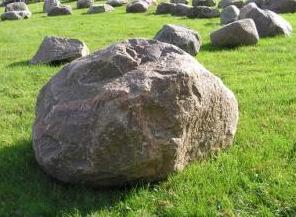Vor der Eiszeit gab es keinen Bodensee. Die ganze Region war ein
Hochland und lag 800 Meter über Meer. Mit dem Vorstoss der
Gletscher vor etwa 25 000 Jahren begrub der Rheingletscher das
Hochland unter sich und begann in den Untergrund zu erodieren, rund
900 Meter tief. Der Eispanzer war zur Zeit der grössten
Vergletscherung bis zu 1200 Meter dick. Die Gesteinspartikel im Eis
schliffen die heutige, sanfte Landschaftsform. Mit diesem
Earthcache möchten wir Dir ein Beispiel für die Spuren des
Rheingletschers zeigen:
Ein Findling, auch Erratischer Block oder Erratiker genannt, ist
ein heute meist einzeln liegender sehr großer Stein, der durch
Gletscher während der Eiszeiten in seine heutige Lage transportiert
und abgelegt wurde. Die Grenze zwischen Findlingen und den
kleineren Geschieben zieht man bei einem Volumen von einem
Kubikmeter.

Im Hofener Findlingsgarten von 1992 sind 2 Erstarrungsgesteine,
7 Umwandlungsgesteine und 48 Ablagerungsgesteine beschildert. Der
Würmgletscher brachte sie von linksrheinischen Felsabbrüchen in das
Gebiet des Autobahnzubringers.
Um diesen Earthcache zu loggen, erfülle bitte folgende
Aufgaben:
• Um welches Gestein handelt es sich bei der Nr. 3?
(Antwort 1)
• Welche Besonderheit hat die Nr. 53? (Antwort 2)
• Wie viele Findlinge stammen aus dem Appenzeller Vorderland?
(Antwort 3)
• Mach ein Foto von Dir oder von Deinem GPS vor den
Findlingen.
Sende eine e-mail an folgende Adresse und füge das Foto
nach Freigabe Deinem Log hinzu.
Antwort1.Antwort2.Antwort3@gmx.ch
Beachte, dass alles ohne Abstand geschrieben sein muss! (zum
Beispiel: Hochgebirgskalk.mitFossilien.03@gmx.ch
)
Wenn die Antworten richtig sind, erhälst Du eine
automatische Antwort mit der Logfreigabe.
----------------------------------------------------------------
The end of the last ice age dates back about 10,000 years.
However, also today tracks of the Rhine glacier
can be still discovered everywhere in the area.
Before the ice age there was no Lake of Constance. The whole
region was a highland and lay 800 metres above the sea level. With
the thrust of the glaciers about 25,000 years ago the Rhine glacier
buried the highland under itself and started to erode in the
subsoil, about 900 metres deep. The ice tank was up to 1200 metres
thick at the moment of the biggest glaciation. The rock particle in
the ice sharpened the today's, gentle scenery form. With this
Earthcache we would like to show you an example of the tracks of
the Rhine glacier:
An erratic block, also erratic block or Erratiker called, is a
very big stone lying mostly individually today which was
transported by glacier during the ice ages in his today's situation
and was filed. One pulls the border between erratic blocks and the
smaller deposits with a volume of 1 cubic metre.
In the “Hofener” erratic block garden of 1992 2
solidification rocks, 7 change rocks and 48 deposition rocks are
labelled. The Würm glacier brought them of rock demolitions on the
left side of the Rhine river to the area of the feeder road.
To log these Earthcache, fulfils please the following
duties:
-Which rock does it concern with the No. 3? (answer 1)
-Which specific feature has the No. 53? (answer 2)
-How many erratic blocks come from the “Appenzeller
Vorderland”? (answer 3)
-Take a photo of you or from your GPS before the erratic
blocks.
Send an email to the following address and
add the photo after release to your log.
answer1.answer2.answer3@gmx.ch
Note that everything must be written without distance! (for
example: Hochgebirgskalk.mitFossilien.03@gmx.ch)
If your answers are correct, you will receive an autoresponder
message allowing you to log the cache.